Gardening enthusiasts often grapple with the challenges posed by pests, particularly the elusive lychee erinose mite. This tiny menace can wreak havoc on lychee trees, leading to significant yield losses and compromised plant health. However, there is hope!
Fortunately, effective treatment strategies are available that not only target these pests but also promote sustainable gardening practices. How can we navigate the complexities of pest management while ensuring the vitality of our tropical fruit plants? This article unveils nine powerful strategies for combating lychee erinose mites, empowering you to cultivate thriving, resilient gardens.
Thinking about growing lychee in your garden?
Gardening can be a rewarding yet challenging journey, especially when faced with pests like the lychee erinose mite. It's important to know that you're not alone in this struggle. There are effective treatment strategies available that can help you nurture your lychee plants back to health.
Consider exploring a variety of methods, such as:
- Chemical practices
- Biological practices
- Cultural practices
For instance, treatments like abamectin and the beneficial fungus Hirsutella thompsonii can make a significant difference. Additionally, preventative measures like proper sanitation, adequate spacing, and ongoing education are vital in fostering healthier plants and reducing pest infestations.
Imagine how satisfying it would be to see your lychee trees thrive, free from the worry of pests. By implementing these strategies, you can create a more vibrant garden. Remember, every small step you take contributes to a healthier ecosystem.
As you embark on this journey, think about your own experiences with pests in your garden. What has worked for you in the past? By sharing these insights and learning from one another, we can cultivate a supportive community that thrives together. Let's take these actionable steps to protect our gardens and enjoy the fruits of our labor.
Everglades Farm: Quality Tropical Fruit Trees with Pest Management Solutions
At Everglades Farm, we understand the joy and challenges of gardening, which is why we are dedicated to providing high-quality tropical fruit plants, including lychee, as well as effective solutions for lychee erinose mite treatment. Our commitment to sustainability means that you receive robust plants that thrive in Florida's unique climate.
Explore our Fast-Growing Plants collection, featuring vibrant, high-yield specimens that not only enhance your garden but also promise quick yields for home gardeners like you. By embracing integrated pest management strategies—such as eco-friendly chemicals and expert pest identification—we empower you to cultivate vibrant, fruitful gardens while confidently addressing pest-related challenges, including the need for lychee erinose mite treatment.
Sustainable practices not only improve the health of your tropical fruit plants but also support a flourishing ecosystem, making them essential for anyone looking to nurture a healthy garden environment. Our customer testimonials speak volumes about our dedication, with 79% of reviews rating Everglades Farm's service as five stars. This reflects the exceptional quality of our tropical fruit trees and the care we take in their delivery.
Expert opinions reinforce the importance of these strategies. Aldo Leopold wisely noted that agricultural science is a race between new pests and new control techniques, highlighting that sustainable pest management, such as lychee erinose mite treatment, is crucial for the long-term success of tropical gardening. Together, let's cultivate a thriving garden that brings you joy and sustains the environment.
Abamectin: A Chemical Control for Lychee Erinose Mite
Abamectin is a highly effective acaricide developed for lychee erinose mite treatment, offering a solution for many gardeners facing this challenge. This chemical works by interfering with the pests' nervous systems, leading to paralysis and ultimately, death. To achieve the best results, it's essential to apply abamectin at the onset of infestations, ensuring comprehensive coverage of the foliage, especially on the undersides of leaves where these pests often hide. Regular applications may be necessary to maintain control, particularly during peak infestation periods.
While abamectin shows promise, it's important to note that its effectiveness in Florida is still under investigation. Research indicates that it may struggle to penetrate the galls created by these pests, known as 'erinea.' Therefore, combining abamectin with other management strategies, such as horticultural oils or surfactants, can enhance the overall effectiveness of lychee erinose mite treatment. In the realm of Florida agriculture, using chemical pesticides like abamectin is a common practice, but continuous assessments are vital to determine the most effective methods for controlling pests on your fruit.
As you navigate your gardening journey, remember that you're not alone. By staying informed and adapting your approach, you can create a thriving garden. Together, let’s explore the best practices for managing these pests and ensuring the health of your plants.
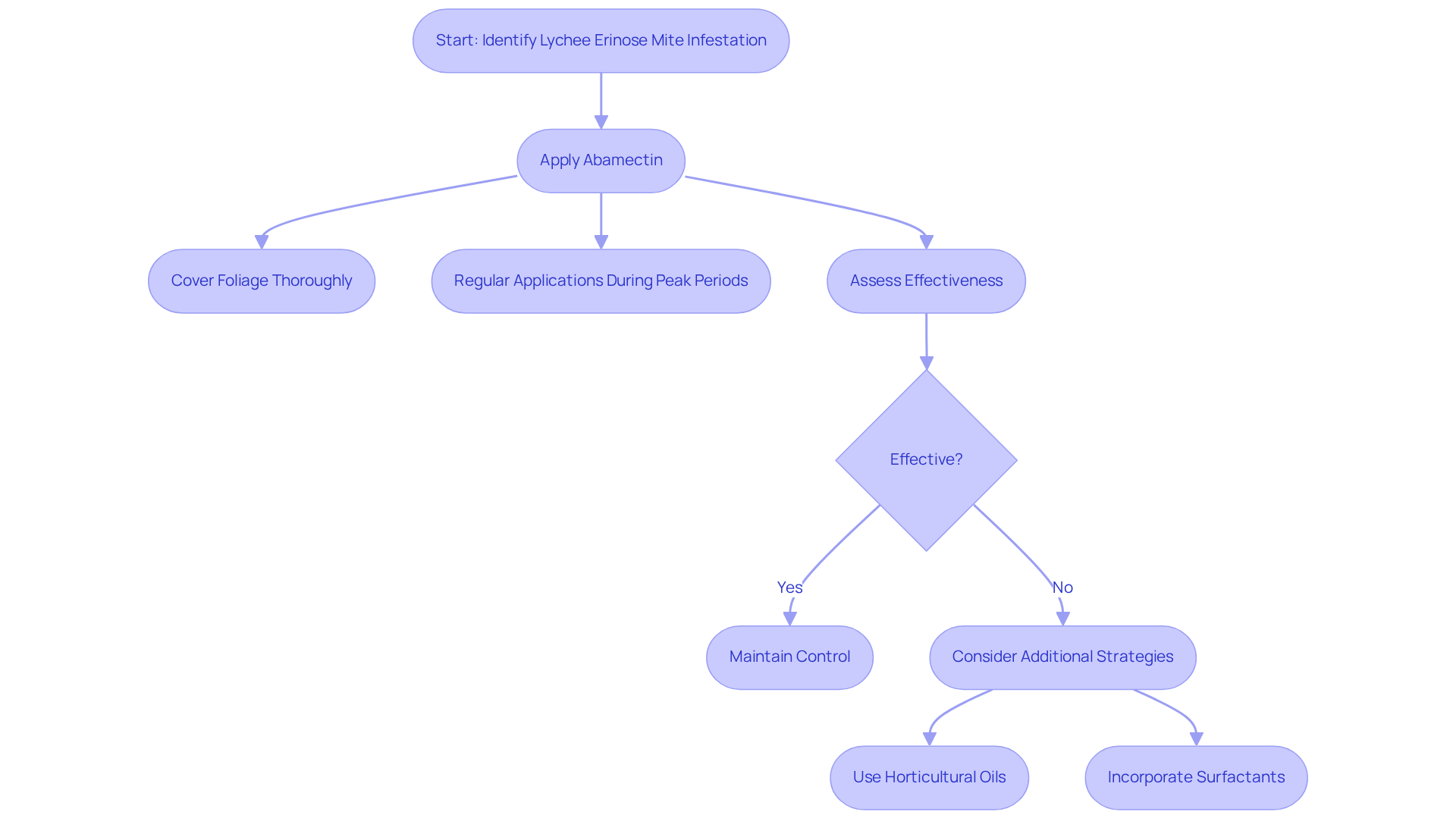
Cultural Practices: Enhancing Plant Health to Prevent Mite Infestations
Caring for your lychee trees is essential not only for their health but also for creating a thriving garden environment. We understand that managing pests like the lychee erinose requires effective lychee erinose mite treatment, but there are nurturing strategies you can implement. Proper watering, balanced fertilization, and effective pruning techniques are key to enhancing the vitality of your trees. Remember, it's important to avoid excessive nitrogen fertilization, as it can lead to dense growth that attracts pests. Instead, focus on maintaining ideal moisture levels through precise watering techniques. Drip irrigation can be a wonderful tool to reduce excess moisture on leaves, lowering the risk of pest multiplication.
Furthermore, ensuring sufficient air circulation around your trees is crucial. By applying appropriate spacing and practicing regular pruning, you create an environment that is less inviting to pests. Monitoring soil moisture levels is equally important; over-irrigation can foster conditions that harmful insects thrive in. Understanding the habitat needs of specific pests can help you cultivate a garden setting that naturally deters them.
These caring practices not only boost the health of your lychee trees but also contribute to a more resilient garden ecosystem. Embrace these nurturing strategies, and you'll find joy in watching your garden flourish. Together, we can create a vibrant space where both plants and gardeners thrive.
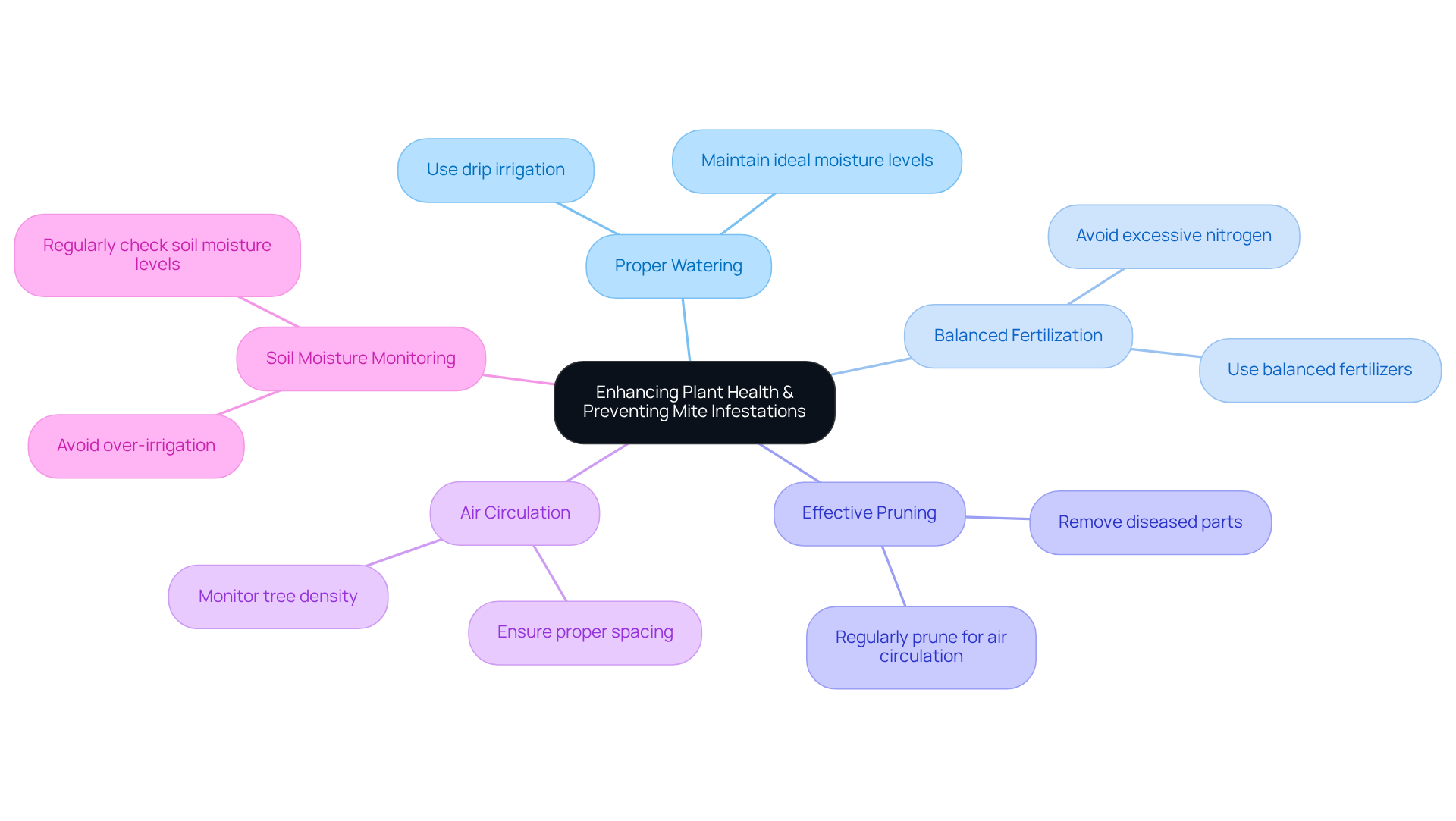
Hirsutella thompsonii: A Biological Control Agent for Lychee Erinose Mite
Hirsutella thompsonii is a remarkable fungal ally in our gardening journey, known for its effectiveness as a lychee erinose mite treatment. This natural solution not only targets and eliminates these pests but also offers a nurturing alternative to chemical pesticides. To achieve the best results, it’s important to apply Hirsutella thompsonii during periods of high humidity when pest populations thrive. This method significantly reduces mite numbers, creating a healthier garden ecosystem and lessening our reliance on synthetic chemicals.
Embracing biological control methods like Hirsutella thompsonii aligns beautifully with sustainable gardening practices. It nurtures healthier plants and contributes to environmental conservation, which we all care about deeply. Additionally, incorporating organic insect management techniques—similar to those used for passion fruit vines—can enhance the vitality of tropical fruit plants like soursop and passion fruit.
In Florida, gardening enthusiasts are increasingly turning to eco-friendly solutions. The adoption of biological pest control has shown promising results, with studies revealing that these methods can effectively manage pest populations while improving overall garden health. Have you considered how these practices could transform your garden? Together, we can cultivate a thriving, sustainable space that not only meets our needs but also nurtures the environment we cherish.
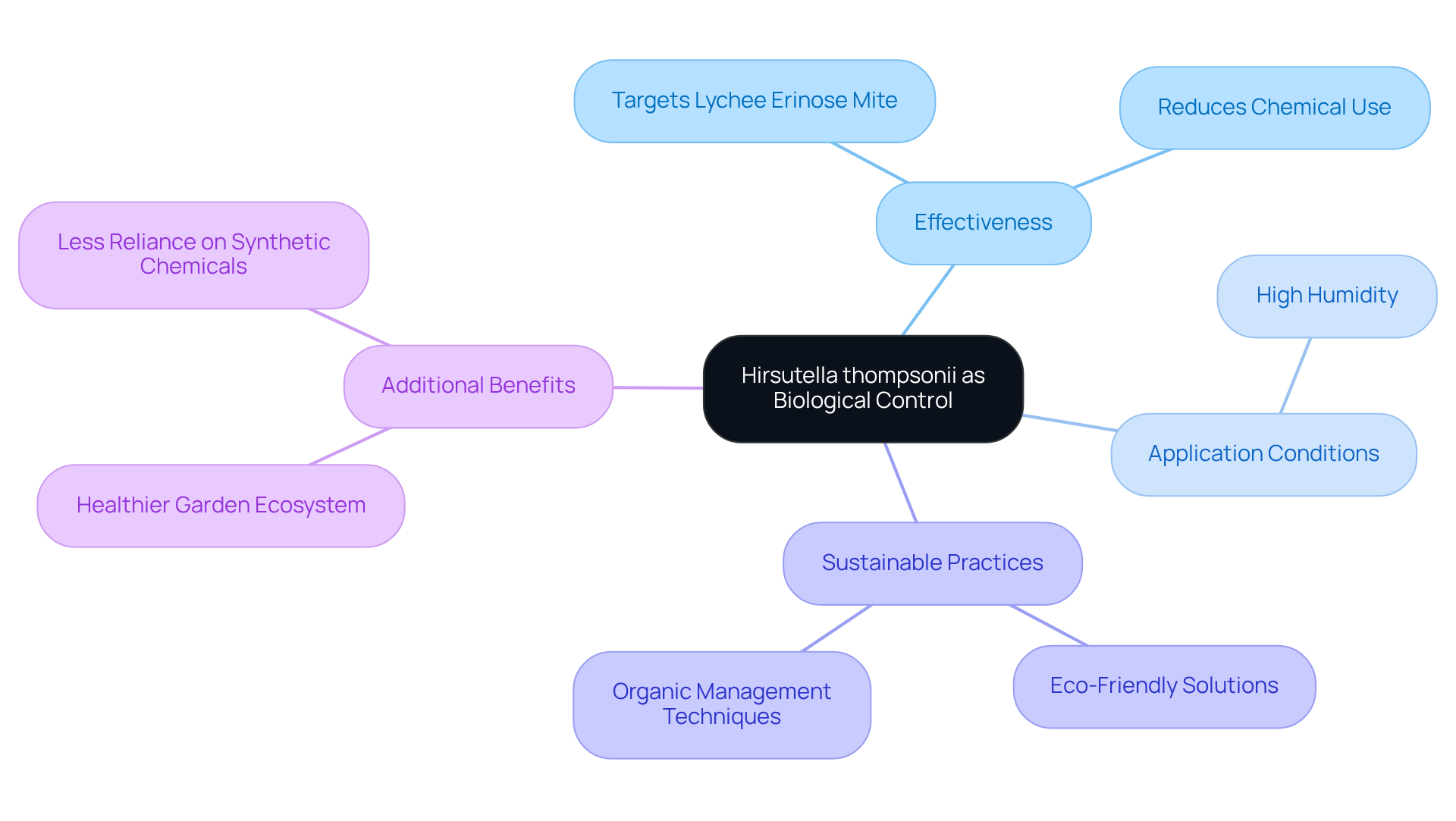
Regular Monitoring: Scouting for Early Detection of Lychee Erinose Mite
Consistently observing your lychee plants is crucial for spotting lychee erinose mite treatment early on. As gardeners, we understand how concerning pest infestations can be. Make it a habit to inspect the foliage thoroughly, particularly the undersides of leaves, where you might notice signs of trouble, like distorted growth and reddish-brown galls. By establishing a regular scouting schedule, especially during the growing season, you can catch infestations before they become serious. This proactive approach allows for timely interventions, helping to minimize potential harm to your beloved plants.
Experts recommend combining visual inspections with traps to capture and assess pest populations. By incorporating these methods into your gardening routine, you can effectively manage LEM with lychee erinose mite treatment and keep your fruit trees healthy. Remember, you’re not alone in this journey; we’re all in this together, nurturing our gardens with care and attention.
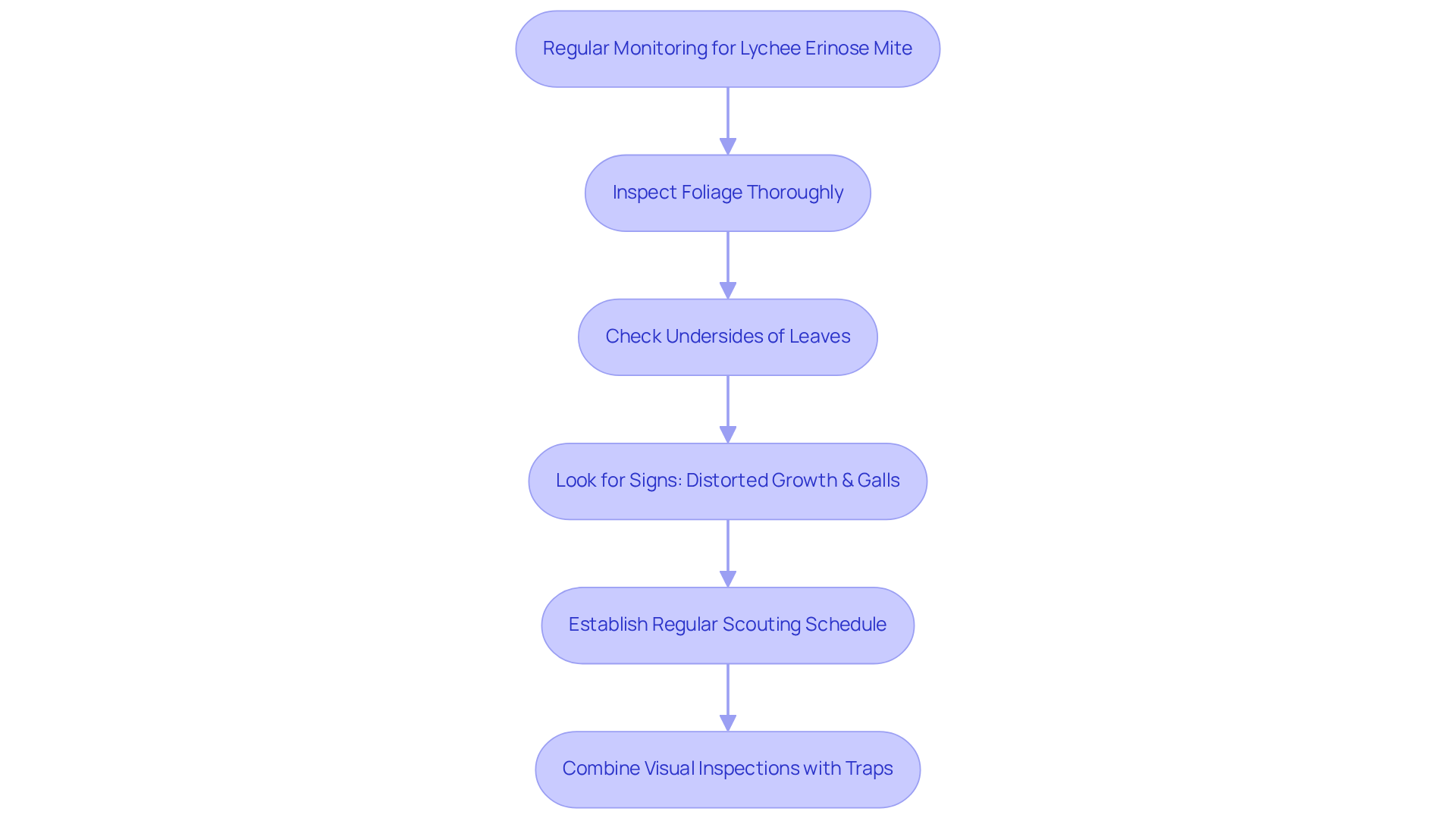
Horticultural Oils: Effective Treatment for Lychee Erinose Mite Control
Horticultural oils serve as a compassionate remedy for the lychee erinose mite treatment, effectively suffocating these pests and disrupting their life cycle. To ensure the best results, these oils should be lovingly applied during the cooler parts of the day, helping to prevent leaf burn. It's essential to achieve complete coverage of the foliage, especially on the undersides of leaves where those small pests often hide. Regular applications of lychee erinose mite treatment are crucial, especially during peak mite activity periods, to maintain effective control over infestations. In Florida, many gardeners have embraced the use of horticultural oils, with numerous reports of significant improvements in insect management.
By following these optimal methods, including cultural practices like removing and incinerating infested branches, we can efficiently protect our fruit plants and enhance overall fruit yield. If you're considering growing soursop, remember to:
- Choose a well-drained location that basks in ample sunlight.
- Ensure proper spacing between plants to promote air circulation.
Implementing organic pest management techniques can further nurture the health and yield of your garden. Together, we can create a thriving garden that brings joy and abundance!
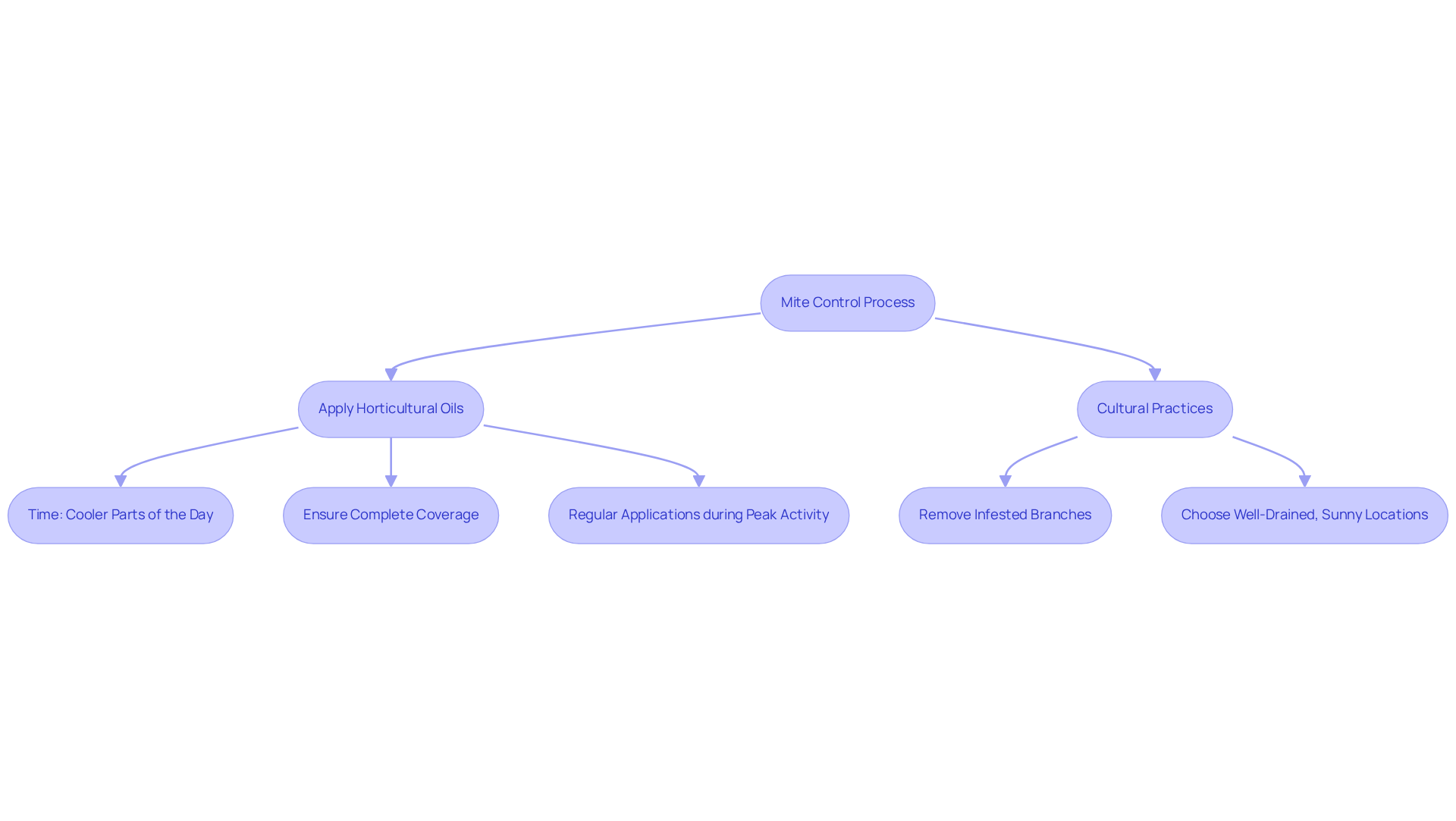
Proper Spacing: Reducing Mite Infestation Risks through Airflow Management
Spacing your lychee plants adequately is not just a technical requirement; it’s a nurturing practice that can significantly minimize the risk of pest infestations. By allowing sufficient space between each plant, you enhance airflow, which helps reduce humidity levels around them. These conditions are less favorable for pests, creating a healthier environment for your plants.
Moreover, when your plants aren’t overcrowded, they face less competition for essential resources like sunlight and nutrients. This encourages healthier growth, making them more resilient against insect attacks. Remember, a little extra space can go a long way in fostering a thriving garden.
As you tend to your plants, think about how much they benefit from this care. By giving them room to breathe, you’re not just preventing pests; you’re nurturing their growth and well-being. So, take a moment to assess your garden layout and consider how you can create a more supportive environment for your beloved lychee plants.
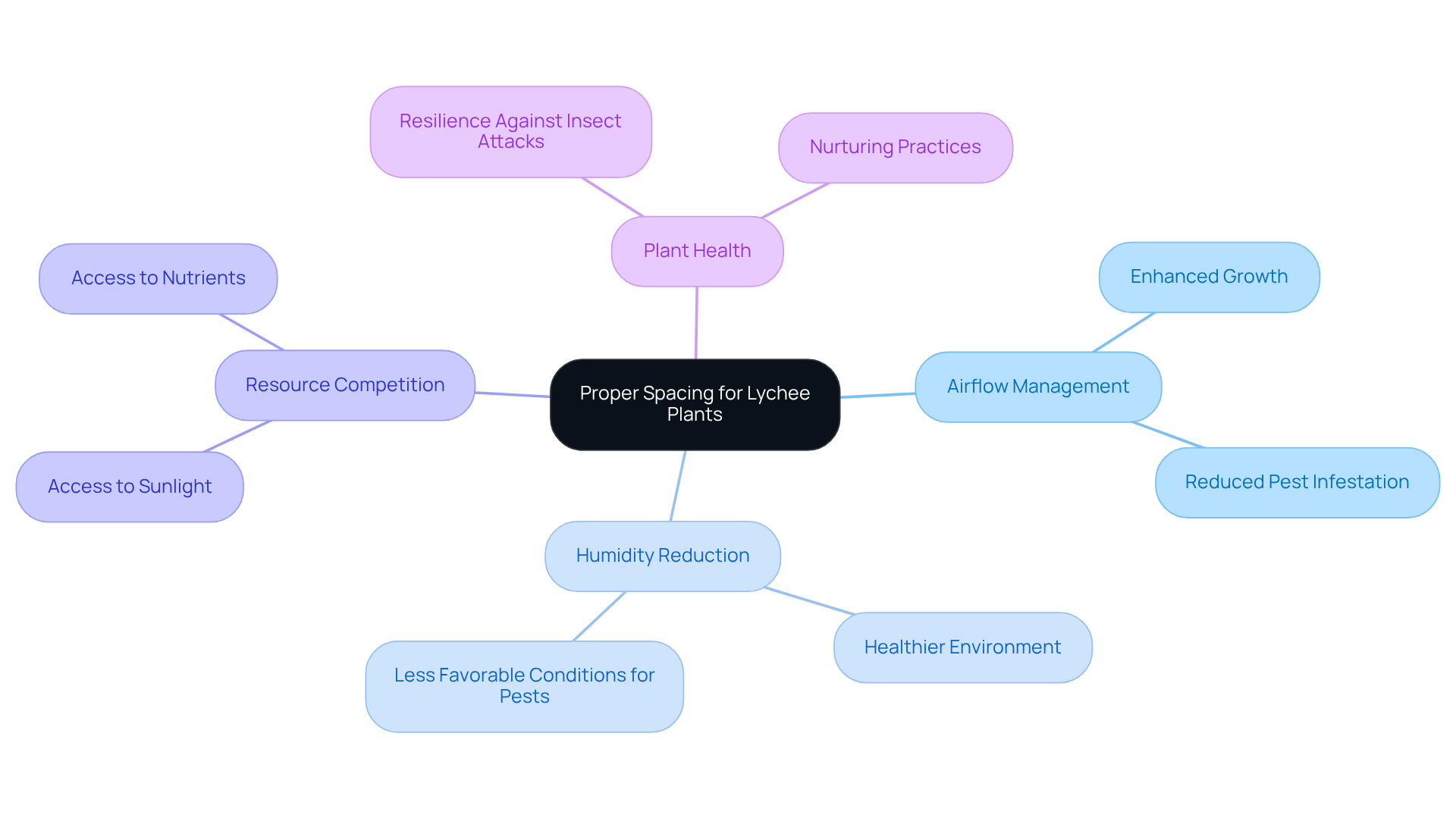
Resistant Varieties: Choosing Lychee Trees Less Susceptible to Mites
Selecting varieties of fruit trees that show resistance to erinose pests is a vital step for effective lychee erinose mite treatment. Varieties like 'Mauritius' and 'Brewster' have proven to be resilient against pest infestations, making them excellent choices for our gardens. Did you know that the lychee erinose mite treatment is necessary because the pest can cause an 80% yield reduction in some areas? This stark reality highlights the importance of choosing resistant varieties. When you choose your plants, consider asking about their pest vulnerability and prioritize those developed for resistance. This thoughtful approach not only reduces our reliance on chemical treatments but also nurtures a healthier garden ecosystem.
Many cultivators share success stories that underscore the efficiency of these resilient varieties. For instance, those who have planted 'Mauritius' report healthier plants and improved yields. This reinforces the significance of selecting pest-resistant options. By focusing on these varieties, we can cultivate flourishing fruit plants while easing the challenges posed by the lychee erinose mite treatment. Remember, every small step we take in our gardening journey contributes to a more vibrant and productive garden. Let's embrace these resilient choices together!
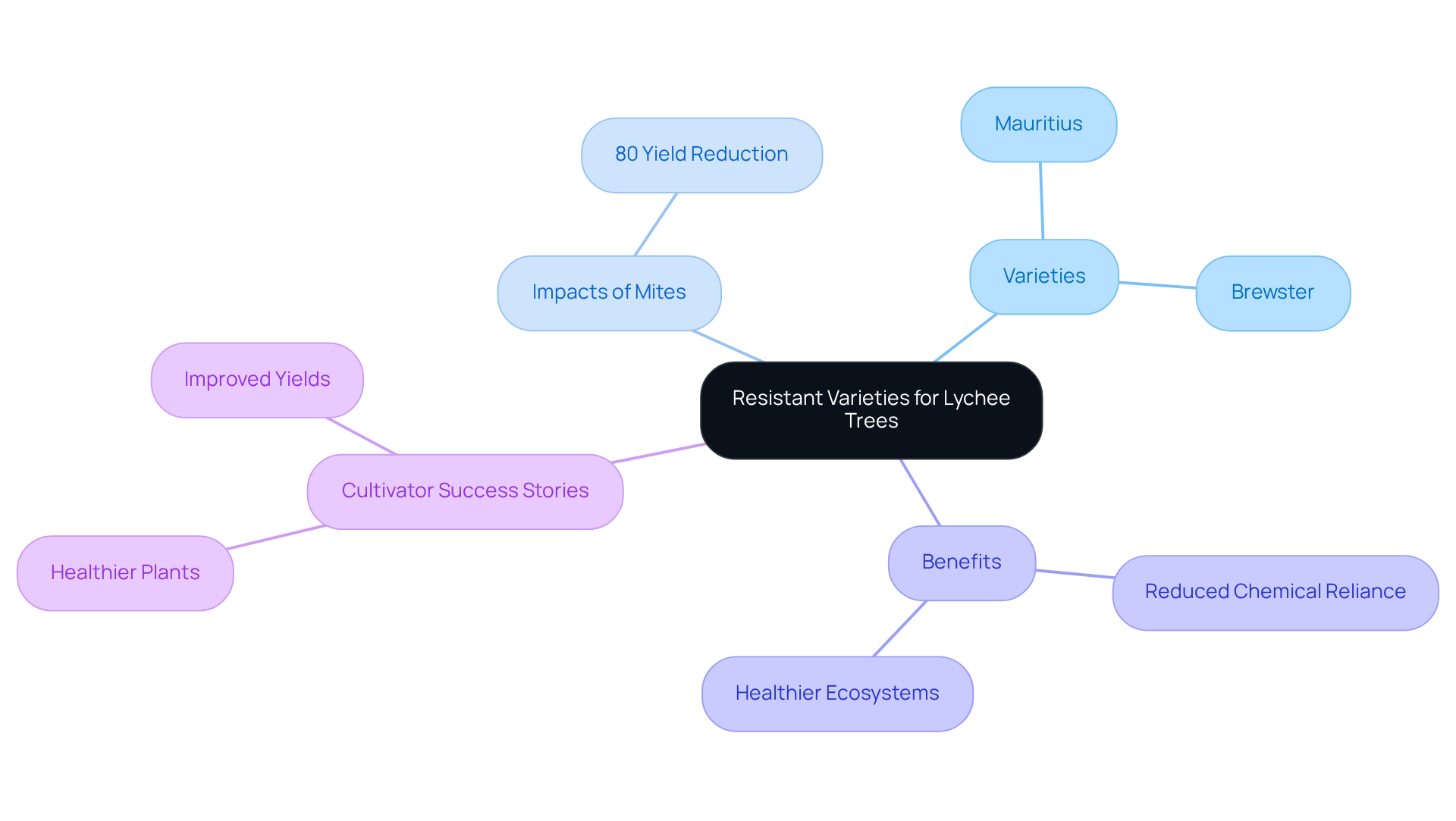
Sanitation Practices: Preventing the Spread of Lychee Erinose Mite
Caring for your garden involves more than just nurturing plants; it also means using lychee erinose mite treatment to protect them from pests. One of the most effective ways to do this is by applying efficient sanitation methods. Have you ever noticed how quickly pests can spread? Regularly eliminating and discarding any infested leaves or debris around your plants is a crucial step in keeping them healthy. Additionally, cleaning your tools and equipment after working with affected plants can prevent the accidental transfer of mites to your healthy trees.
Research shows that maintaining a clean garden environment can significantly reduce the likelihood of infestations. In fact, good sanitation practices can enhance your pest management efforts by up to 17-fold! It’s important to remember that adult insects are more vulnerable to poor sanitation than pupae, which highlights the necessity of cleanliness in your garden. As we strive for a thriving garden, we must acknowledge that harmful organisms can damage up to 40% of crops worldwide.
By implementing successful sanitation strategies, you not only protect your plants but also promote overall garden health through effective lychee erinose mite treatment. This is an essential practice for any gardener who cares deeply about their green space. Let's embrace sanitation as a vital part of comprehensive crop management, ensuring that our gardens flourish and thrive!
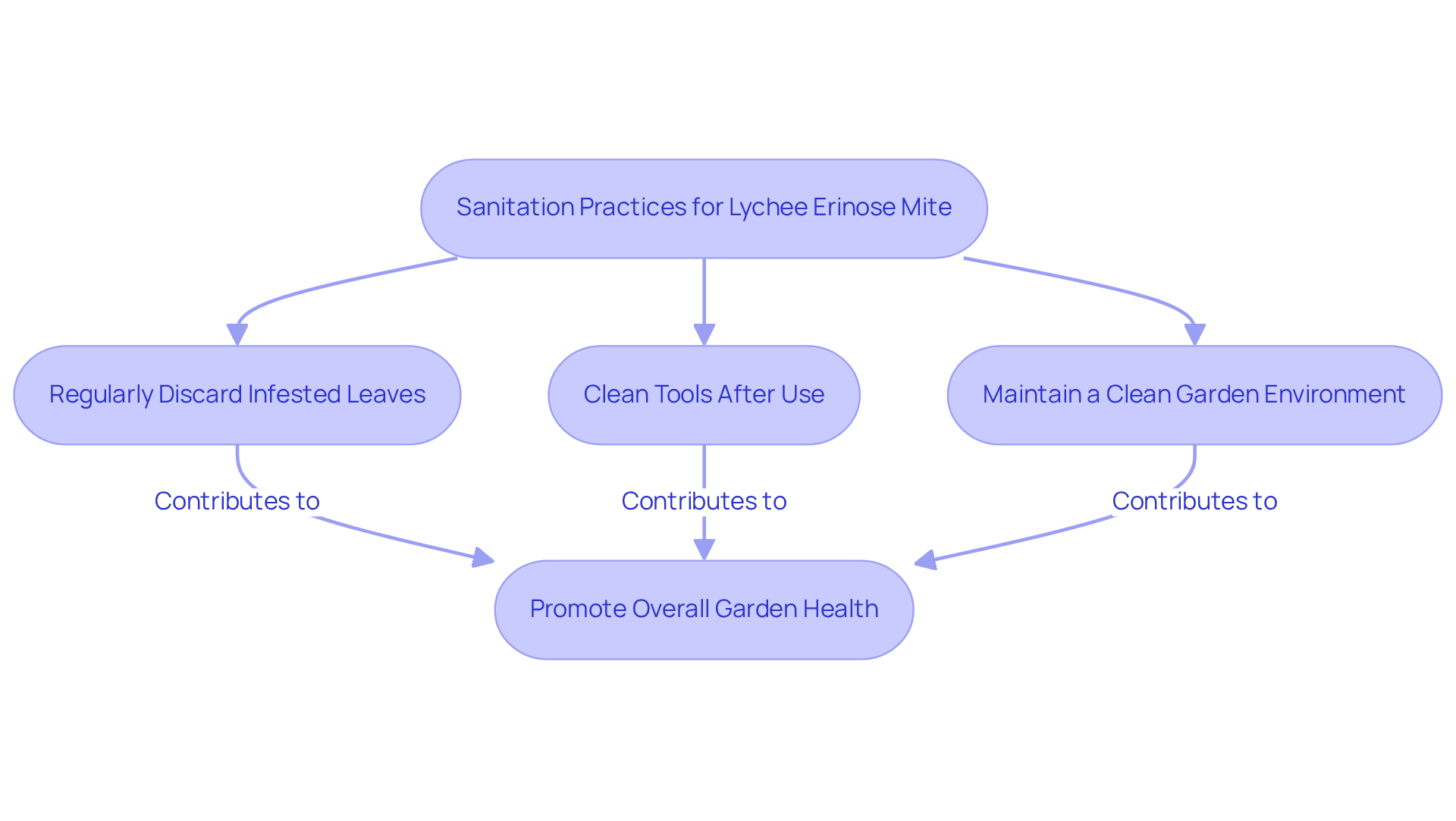
Conclusion
Caring for your lychee trees means effectively managing lychee erinose mites, a crucial step in ensuring their health and productivity. By embracing a blend of chemical, cultural, biological, and monitoring strategies, we can work together to significantly lessen the impact of these pests. Sustainable practices not only safeguard our beloved plants but also nurture a healthier ecosystem, allowing our gardens to flourish for many years ahead.
Key strategies to consider include:
- Using abamectin for immediate pest control
- Applying horticultural oils to suffocate the mites
- Introducing biological control agents like Hirsutella thompsonii
- Implementing cultural practices such as proper watering, pruning, and spacing to prevent infestations
- Regular monitoring and sanitation efforts to enhance these strategies, enabling early detection and management of potential outbreaks
Ultimately, the journey toward effective lychee erinose mite treatment is a collaborative effort that brings together our knowledge, resources, and shared experiences as gardeners. By staying informed and proactive, we can cultivate a thriving garden that not only yields delicious fruit but also champions environmental sustainability. Let’s embrace these strategies and take action today to nurture our gardens, ensuring they remain vibrant and productive spaces for the future.
Explore:
👉🏻 About Everglades Farm
Frequently Asked Questions
What types of tropical fruit plants does Everglades Farm offer?
Everglades Farm offers high-quality tropical fruit plants, including lychee, along with effective solutions for pest management, specifically targeting lychee erinose mite treatment.
What is the commitment of Everglades Farm regarding sustainability?
Everglades Farm is dedicated to sustainability, providing robust plants that thrive in Florida's unique climate while employing integrated pest management strategies to support a healthy garden ecosystem.
How do integrated pest management strategies help gardeners?
Integrated pest management strategies, such as eco-friendly chemicals and expert pest identification, empower gardeners to cultivate vibrant gardens while effectively addressing pest-related challenges, including lychee erinose mite treatment.
What are customer reviews like for Everglades Farm?
Customer testimonials indicate a high level of satisfaction, with 79% of reviews rating Everglades Farm's service as five stars, reflecting the exceptional quality of their tropical fruit trees and care in delivery.
What is abamectin, and how does it work for lychee erinose mite treatment?
Abamectin is an effective acaricide developed for treating lychee erinose mite infestations. It works by interfering with the pests' nervous systems, leading to paralysis and death.
When should abamectin be applied for the best results?
Abamectin should be applied at the onset of infestations for the best results, ensuring comprehensive coverage of the foliage, especially on the undersides of leaves where pests often hide.
What challenges exist with using abamectin in Florida?
While abamectin shows promise, its effectiveness in Florida is still under investigation, as it may struggle to penetrate the galls created by the pests, known as 'erinea.'
What cultural practices can help prevent mite infestations on lychee trees?
Key cultural practices include proper watering, balanced fertilization, effective pruning, and ensuring sufficient air circulation around the trees to create an environment less inviting to pests.
How can excessive nitrogen fertilization affect lychee trees?
Excessive nitrogen fertilization can lead to dense growth that attracts pests, so it's important to maintain balanced fertilization for the health of the trees.
What role does monitoring soil moisture play in pest management?
Monitoring soil moisture is crucial, as over-irrigation can create conditions that foster harmful insects, so maintaining ideal moisture levels helps deter pests.





0 comments